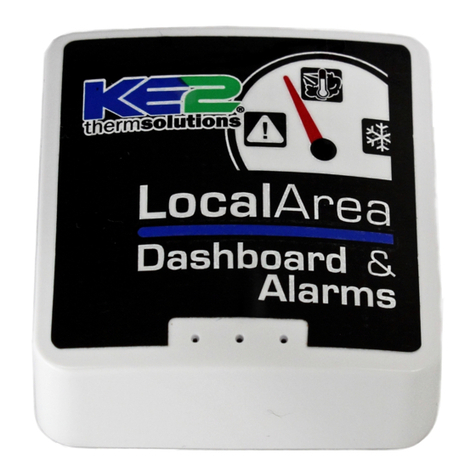
© Copyright 2023 KE2 Therm Solutions, Inc., Washington, Missouri 63090
KE2 EvapOEM
Alarm Troubleshooting Guide Q.1.61 January 2023
21214V3.0
Users are notied of alarms in multiple ways, described below.
From the face of the Basic Display:
The alarm is shown as a three digit code on the Basic Display, and the yel-
low or red LED light on the right side of the display will illuminate. If there
is more than one alarm present at the same time, press to cycle through
the alarms.
Alarm Severity:
Red LED: Critical Alarm - The controller will close the electric
expansion valve (EEV) to prevent compressor damage. This will
likely prevent refrigeration from continuing, but the con-
troller is attempting to prevent a catastrophic system fail-
ure, such as damage to the compressor. Critical alarms
must be addressed immediately.
Yellow LED: Cautionary Alarm - The controller will con-
tinue to function to the best extent possible given the
system conditions, but the alarm should be addressed
as soon as possible.
On the controller’s webpage:
Alarms can also be viewed in the top right-hand side of
the controller’s webpage as a pulsing yellow or red bell
when connected to the controller via a smart device (smartphone, tablet,
PC etc.), or remotely via KE2 SmartAccess. When not in alarm, no bell is dis-
played.
If the controller is connected to the internet, the KE2 Evap OEM can also send
text messages and/or emails to immediately notify all necessary personnel
of the alarm condition.
Alarm thresholds such as high temp and door alarm can be adjusted, and
should be set so as not to trigger
during normal loading and use.
Almost all alarms will automati-
cally clear once the alarm con-
dition no longer exists. To clear
an alarm manually, press and
hold until tS (temperature
Setpoint) appears, press sev-
eral times to CLA (CLear Alarm),
press and hold until the
red LED blinks, then release.
Power cycling the controller to
clear alarms is not recommend-
ed, but will also reset the alarm
conditions.
Clearing alarms before calling
technical support will make
diagnosis more dicult or im-
possible; please call technical
support before clearing alarms
if assistance is required.
Note: If the alarm is a sensor
alarm and the sensor is still dis-
connected or shorted, the alarm
will immediately reappear.
Troubleshooting:
Video 034 – Iced Evaporator Coil on a Walk-in Freezer
Video 044 – Iced Evaporator Coil on a Walk-in Cooler
Video 107 –Troubleshooting a Temperature Sensor
Video 106 –Troubleshooting a PressureTransducer
Introduction:
The KE2 Evap OEM has advanced communications and alarming features, never
before seen in the refrigeration industry. These alarms provide early indications of
a poorly performing refrigeration system.
Text messages and/or email alerts provide notication of system issues
immediately, whether on-site or remote, as long as there is an internet connection.
Advanced alarming, diagnostic and troubleshooting are key features of the
KE2 Evap OEM controller, and help prevent catastrophic failures. This protects
contractor, owner, product, and refrigeration equipment.
When using KE2 SmartAccess, the controllers can be viewed, setpoints changed, and defrosts initiated remotely; saving time and frustration. In addition,
your home oce or KE2 Therm technical support can even login with you to diagnose the system in real time.
Alarm Notications:
Basic setup:
Video 068 – How to Determine Proper Coil Sensor Location
Video 069 – How to Properly Install a Coil Sensor
These videos are relevant when troubleshooting
or for basic setup of your controller.




























